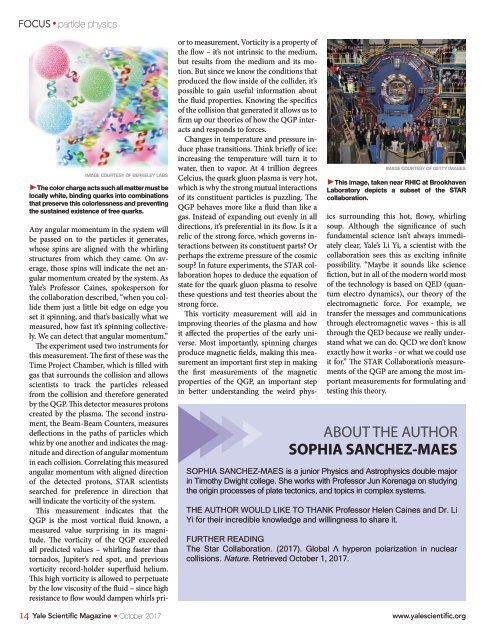YSM Issue 90.4
You also want an ePaper? Increase the reach of your titles
YUMPU automatically turns print PDFs into web optimized ePapers that Google loves.
FOCUS<br />
particle physics<br />
IMAGE COURTESY OF BERKELEY LABS<br />
►The color charge acts such all matter must be<br />
locally white, binding quarks into combinations<br />
that preserve this colorlessness and preventing<br />
the sustained existence of free quarks.<br />
IMAGE COURTESY OF GETTY IMAGES<br />
►This image, taken near RHIC at Brookhaven<br />
Laboratory depicts a subset of the STAR<br />
collaboration.<br />
Any angular momentum in the system will<br />
be passed on to the particles it generates,<br />
whose spins are aligned with the whirling<br />
structures from which they came. On average,<br />
those spins will indicate the net angular<br />
momentum created by the system. As<br />
Yale’s Professor Caines, spokesperson for<br />
the collaboration described, “when you collide<br />
them just a little bit edge on edge you<br />
set it spinning, and that’s basically what we<br />
measured, how fast it’s spinning collectively.<br />
We can detect that angular momentum.”<br />
The experiment used two instruments for<br />
this measurement. The first of these was the<br />
Time Project Chamber, which is filled with<br />
gas that surrounds the collision and allows<br />
scientists to track the particles released<br />
from the collision and therefore generated<br />
by the QGP. This detector measures protons<br />
created by the plasma. The second instrument,<br />
the Beam-Beam Counters, measures<br />
deflections in the paths of particles which<br />
whiz by one another and indicates the magnitude<br />
and direction of angular momentum<br />
in each collision. Correlating this measured<br />
angular momentum with aligned direction<br />
of the detected protons, STAR scientists<br />
searched for preference in direction that<br />
will indicate the vorticity of the system.<br />
This measurement indicates that the<br />
QGP is the most vortical fluid known, a<br />
measured value surprising in its magnitude.<br />
The vorticity of the QGP exceeded<br />
all predicted values – whirling faster than<br />
tornados, Jupiter’s red spot, and previous<br />
vorticity record-holder superfluid helium.<br />
This high vorticity is allowed to perpetuate<br />
by the low viscosity of the fluid – since high<br />
resistance to flow would dampen whirls prior<br />
to measurement. Vorticity is a property of<br />
the flow – it’s not intrinsic to the medium,<br />
but results from the medium and its motion.<br />
But since we know the conditions that<br />
produced the flow inside of the collider, it’s<br />
possible to gain useful information about<br />
the fluid properties. Knowing the specifics<br />
of the collision that generated it allows us to<br />
firm up our theories of how the QGP interacts<br />
and responds to forces.<br />
Changes in temperature and pressure induce<br />
phase transitions. Think briefly of ice:<br />
increasing the temperature will turn it to<br />
water, then to vapor. At 4 trillion degrees<br />
Celcius, the quark gluon plasma is very hot,<br />
which is why the strong mutual interactions<br />
of its constituent particles is puzzling. The<br />
QGP behaves more like a fluid than like a<br />
gas. Instead of expanding out evenly in all<br />
directions, it’s preferential in its flow. Is it a<br />
relic of the strong force, which governs interactions<br />
between its constituent parts? Or<br />
perhaps the extreme pressure of the cosmic<br />
soup? In future experiments, the STAR collaboration<br />
hopes to deduce the equation of<br />
state for the quark gluon plasma to resolve<br />
these questions and test theories about the<br />
strong force.<br />
This vorticity measurement will aid in<br />
improving theories of the plasma and how<br />
it affected the properties of the early universe.<br />
Most importantly, spinning charges<br />
produce magnetic fields, making this measurement<br />
an important first step in making<br />
the first measurements of the magnetic<br />
properties of the QGP, an important step<br />
in better understanding the weird physics<br />
surrounding this hot, flowy, whirling<br />
soup. Although the significance of such<br />
fundamental science isn’t always immediately<br />
clear, Yale’s Li Yi, a scientist with the<br />
collaboration sees this as exciting infinite<br />
possibility. “Maybe it sounds like science<br />
fiction, but in all of the modern world most<br />
of the technology is based on QED (quantum<br />
electro dynamics), our theory of the<br />
electromagnetic force. For example, we<br />
transfer the messages and communications<br />
through electromagnetic waves - this is all<br />
through the QED because we really understand<br />
what we can do. QCD we don’t know<br />
exactly how it works - or what we could use<br />
it for.” The STAR Collaboration’s measurements<br />
of the QGP are among the most important<br />
measurements for formulating and<br />
testing this theory.<br />
ABOUT THE AUTHOR<br />
SOPHIA SANCHEZ-MAES<br />
SOPHIA SANCHEZ-MAES is a junior Physics and Astrophysics double major<br />
in Timothy Dwight college. She works with Professor Jun Korenaga on studying<br />
the origin processes of plate tectonics, and topics in complex systems.<br />
THE AUTHOR WOULD LIKE TO THANK Professor Helen Caines and Dr. Li<br />
Yi for their incredible knowledge and willingness to share it.<br />
FURTHER READING<br />
The Star Collaboration. (2017). Global Λ hyperon polarization in nuclear<br />
collisions. Nature. Retrieved October 1, 2017.<br />
14 Yale Scientific Magazine October 2017 www.yalescientific.org


















